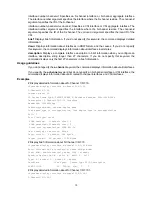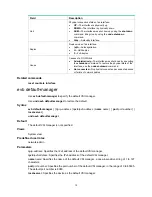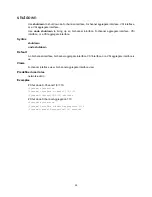
15
Syntax
evb reflective-relay
undo evb reflective-relay
Default
The RR mode for an S-channel is disabled.
Views
S-channel interface view, S-channel aggregate interface view
Predefined user roles
network-admin
Usage guidelines
EVB TLVs exchanged through LLDP allow an EVB station and EVB bridge to negotiate the use of
reflective relay (RR). If the EVB station requests to use the RR mode and the EVB bridge supports
the RR mode, the bridge performs the following operations:
•
Automatically enables the RR mode for the S-channel
•
Adds the corresponding command line to the configuration file.
You can also use this command to manually enable or disable the RR mode for an S-channel.
Examples
# Enable the RR mode on S-Channel 1/0/1:10.
<Sysname> system-view
[Sysname] interface s-channel 1/0/1:10
[Sysname-S-Channel1/0/1:10] evb reflective-relay
# Enable the RR mode on Schannel-Aggregation 1:10.
<Sysname> system-view
[Sysname] interface schannel-aggregation 1:10
[Sysname–Schannel-Aggregation1:10] evb reflective-relay
evb s-channel
Use
evb s-channel
to create an S-channel on an interface.
Use
undo evb s-channel
to remove an S-channel on an interface.
Syntax
evb s-channel channel-id
[
service-vlan
svlan-id
]
undo evb s-channel
channel-id
Default
Only an automatically created default S-channel (with both SCID and SVID as 1) exists on an
interface with EVB enabled.
Views
Layer 2 Ethernet interface view, Layer 2 aggregate interface view
Predefined user roles
network-admin
















































